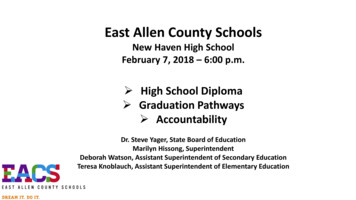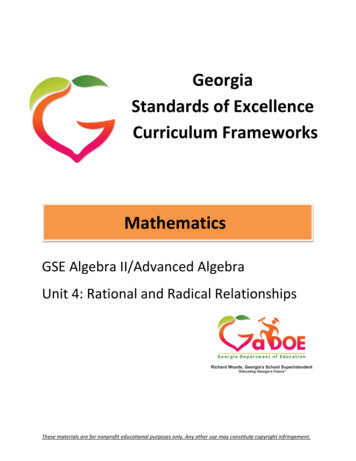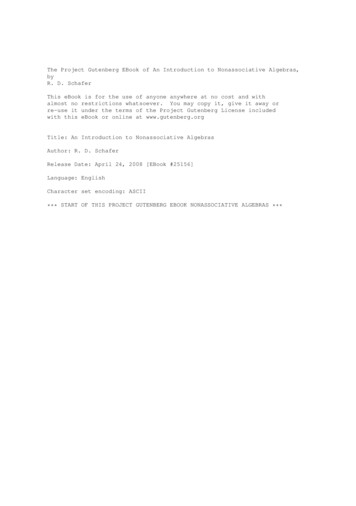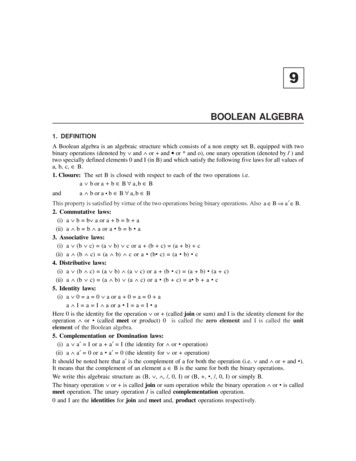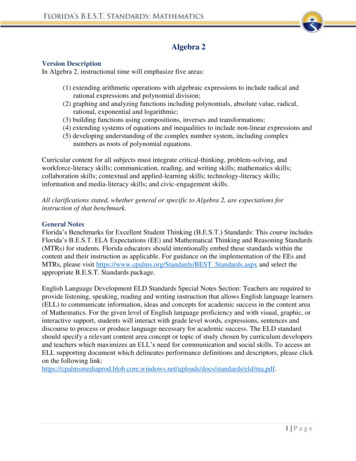
Transcription
Algebra 2Version DescriptionIn Algebra 2, instructional time will emphasize five areas:(1) extending arithmetic operations with algebraic expressions to include radical andrational expressions and polynomial division;(2) graphing and analyzing functions including polynomials, absolute value, radical,rational, exponential and logarithmic;(3) building functions using compositions, inverses and transformations;(4) extending systems of equations and inequalities to include non-linear expressions and(5) developing understanding of the complex number system, including complexnumbers as roots of polynomial equations.Curricular content for all subjects must integrate critical-thinking, problem-solving, andworkforce-literacy skills; communication, reading, and writing skills; mathematics skills;collaboration skills; contextual and applied-learning skills; technology-literacy skills;information and media-literacy skills; and civic-engagement skills.All clarifications stated, whether general or specific to Algebra 2, are expectations forinstruction of that benchmark.General NotesFlorida’s Benchmarks for Excellent Student Thinking (B.E.S.T.) Standards: This course includesFlorida’s B.E.S.T. ELA Expectations (EE) and Mathematical Thinking and Reasoning Standards(MTRs) for students. Florida educators should intentionally embed these standards within thecontent and their instruction as applicable. For guidance on the implementation of the EEs andMTRs, please visit https://www.cpalms.org/Standards/BEST Standards.aspx and select theappropriate B.E.S.T. Standards package.English Language Development ELD Standards Special Notes Section: Teachers are required toprovide listening, speaking, reading and writing instruction that allows English language learners(ELL) to communicate information, ideas and concepts for academic success in the content areaof Mathematics. For the given level of English language proficiency and with visual, graphic, orinteractive support, students will interact with grade level words, expressions, sentences anddiscourse to process or produce language necessary for academic success. The ELD standardshould specify a relevant content area concept or topic of study chosen by curriculum developersand teachers which maximizes an ELL’s need for communication and social skills. To access anELL supporting document which delineates performance definitions and descriptors, please clickon the following /uploads/docs/standards/eld/ma.pdf.1 Page
General InformationCourse Number: 1200330Course Length: Year (Y)Course Type: Core Academic CourseCourse Level: 2Grade Level(s): 9, 10, 11, 12Graduation Requirement: MathematicsNumber of Credits: One (1) creditCourse Path: Section Grades PreK to 12 Education Courses Grade Group Grades 9 to 12and Adult Education Courses Subject Mathematics SubSubject Algebra Abbreviated Title ALG 2Educator Certification: Mathematics (Grades 6-12)Course Standards and BenchmarksMathematical Thinking and ReasoningMA.K12.MTR.1.1 Actively participate in effortful learning both individually andcollectively.Mathematicians who participate in effortful learning both individually and with others: Analyze the problem in a way that makes sense given the task. Ask questions that will help with solving the task. Build perseverance by modifying methods as needed while solving a challenging task. Stay engaged and maintain a positive mindset when working to solve tasks. Help and support each other when attempting a new method or approach.Clarifications:Teachers who encourage students to participate actively in effortful learning both individually andwith others: Cultivate a community of growth mindset learners. Foster perseverance in students by choosing tasks that are challenging. Develop students’ ability to analyze and problem solve. Recognize students’ effort when solving challenging problems.2 Page
MA.K12.MTR.2.1 Demonstrate understanding by representing problems in multiple ways.Mathematicians who demonstrate understanding by representing problems in multiple ways: Build understanding through modeling and using manipulatives. Represent solutions to problems in multiple ways using objects, drawings, tables, graphsand equations. Progress from modeling problems with objects and drawings to using algorithms andequations. Express connections between concepts and representations. Choose a representation based on the given context or purpose.Clarifications:Teachers who encourage students to demonstrate understanding by representing problems in multipleways: Help students make connections between concepts and representations. Provide opportunities for students to use manipulatives when investigating concepts. Guide students from concrete to pictorial to abstract representations as understanding progresses. Show students that various representations can have different purposes and can be useful indifferent situations.MA.K12.MTR.3.1 Complete tasks with mathematical fluency.Mathematicians who complete tasks with mathematical fluency: Select efficient and appropriate methods for solving problems within the given context. Maintain flexibility and accuracy while performing procedures and mental calculations. Complete tasks accurately and with confidence. Adapt procedures to apply them to a new context. Use feedback to improve efficiency when performing calculations.Clarifications:Teachers who encourage students to complete tasks with mathematical fluency: Provide students with the flexibility to solve problems by selecting a procedure that allows themto solve efficiently and accurately. Offer multiple opportunities for students to practice efficient and generalizable methods. Provide opportunities for students to reflect on the method they used and determine if a moreefficient method could have been used.3 Page
MA.K12.MTR.4.1 Engage in discussions that reflect on the mathematical thinking of selfand others.Mathematicians who engage in discussions that reflect on the mathematical thinking of selfand others: Communicate mathematical ideas, vocabulary and methods effectively. Analyze the mathematical thinking of others. Compare the efficiency of a method to those expressed by others. Recognize errors and suggest how to correctly solve the task. Justify results by explaining methods and processes. Construct possible arguments based on evidence.Clarifications:Teachers who encourage students to engage in discussions that reflect on the mathematical thinking ofself and others: Establish a culture in which students ask questions of the teacher and their peers, and error is anopportunity for learning. Create opportunities for students to discuss their thinking with peers. Select, sequence and present student work to advance and deepen understanding of correct andincreasingly efficient methods. Develop students’ ability to justify methods and compare their responses to the responses of theirpeers.MA.K12.MTR.5.1 Use patterns and structure to help understand and connectmathematical concepts.Mathematicians who use patterns and structure to help understand and connect mathematicalconcepts: Focus on relevant details within a problem. Create plans and procedures to logically order events, steps or ideas to solve problems. Decompose a complex problem into manageable parts. Relate previously learned concepts to new concepts. Look for similarities among problems. Connect solutions of problems to more complicated large-scale situations.Clarifications:Teachers who encourage students to use patterns and structure to help understand and connectmathematical concepts: Help students recognize the patterns in the world around them and connect these patterns tomathematical concepts. Support students to develop generalizations based on the similarities found among problems. Provide opportunities for students to create plans and procedures to solve problems. Develop students’ ability to construct relationships between their current understanding and moresophisticated ways of thinking.4 Page
MA.K12.MTR.6.1 Assess the reasonableness of solutions.Mathematicians who assess the reasonableness of solutions: Estimate to discover possible solutions. Use benchmark quantities to determine if a solution makes sense. Check calculations when solving problems. Verify possible solutions by explaining the methods used. Evaluate results based on the given context.Clarifications:Teachers who encourage students to assess the reasonableness of solutions: Have students estimate or predict solutions prior to solving. Prompt students to continually ask, “Does this solution make sense? How do you know?” Reinforce that students check their work as they progress within and after a task. Strengthen students’ ability to verify solutions through justifications.MA.K12.MTR.7.1 Apply mathematics to real-world contexts.Mathematicians who apply mathematics to real-world contexts: Connect mathematical concepts to everyday experiences. Use models and methods to understand, represent and solve problems. Perform investigations to gather data or determine if a method is appropriate. Redesign models and methods to improve accuracy or efficiency.Clarifications:Teachers who encourage students to apply mathematics to real-world contexts: Provide opportunities for students to create models, both concrete and abstract, and performinvestigations. Challenge students to question the accuracy of their models and methods. Support students as they validate conclusions by comparing them to the given situation. Indicate how various concepts can be applied to other disciplines.ELA ExpectationsELA.K12.EE.1.1 Cite evidence to explain and justify reasoning.ELA.K12.EE.2.1 Read and comprehend grade-level complex texts proficiently.ELA.K12.EE.3.1 Make inferences to support comprehension.ELA.K12.EE.4.1 Use appropriate collaborative techniques and active listening skillswhen engaging in discussions in a variety of situations.5 Page
ELA.K12.EE.5.1 Use the accepted rules governing a specific format to create qualitywork.ELA.K12.EE.6.1 Use appropriate voice and tone when speaking or writing.English Language DevelopmentELD.K12.ELL.MA Language of MathematicsELD.K12.ELL.MA.1English language learners communicate information, ideas and conceptsnecessary for academic success in the content area of Mathematics.Number Sense and OperationsMA.912.NSO.1 Generate equivalent expressions and perform operations with expressionsinvolving exponents, radicals or logarithms.MA.912.NSO.1.3Generate equivalent algebraic expressions involving radicals or rationalexponents using the properties of exponents.Benchmark Clarifications:Clarification 1: Within the Algebra 2 course, radicands are limited to monomial algebraic expressions.MA.912.NSO.1.5 Add, subtract, multiply and divide algebraic expressions involving radicals.Benchmark Clarifications:Clarification 1: Within the Algebra 2 course, radicands are limited to monomial algebraic expressions.Given a numerical logarithmic expression, evaluate and generate equivalentMA.912.NSO.1.6 numerical expressions using the properties of logarithms or exponents.Benchmark Clarifications:Clarification 1: Within the Mathematics for Data and Financial Literacy course, problem types focus onmoney and business.Given an algebraic logarithmic expression, generate an equivalent algebraicMA.912.NSO.1.7 expression using the properties of logarithms or exponents.Benchmark Clarifications:Clarification 1: Within the Mathematics for Data and Financial Literacy Honors course, problem typesfocus on money and business.6 Page
MA.912.NSO.2 Represent and perform operations with expressions within the complexnumber system.Extend previous understanding of the real number system to include thecomplex number system. Add, subtract, multiply and divide complexMA.912.NSO.2.1numbers.Algebraic ReasoningMA.912.AR.1 Interpret and rewrite algebraic expressions and equations in equivalentforms.MA.912.AR.1.1Identify and interpret parts of an equation or expression that represent aquantity in terms of a mathematical or real-world context, including viewingone or more of its parts as a single entity.Algebra 1 Example: Derrick is using the formula 𝑃 1000(1 .1)𝑡 to make aprediction about the camel population in Australia. Heidentifies the growth factor as (1 .1), or 1.1, and states thatthe camel population will grow at an annual rate of 10% peryear.112𝑡Example: The expression 1.15𝑡 can be rewritten as (1.1512 ) which isapproximately equivalent to 1.01212𝑡 . This latter expression reveals theapproximate equivalent monthly interest rate of 1.2% if the annual rate is15%.Benchmark Clarifications:Clarification 1: Parts of an expression include factors, terms, constants, coefficients and variables.Clarification 2: Within the Mathematics for Data and Financial Literacy course, problem types focus onmoney and business.MA.912.AR.1.3Add, subtract and multiply polynomial expressions with rational numbercoefficients.Benchmark Clarifications:Clarification 1: Instruction includes an understanding that when any of these operations are performedwith polynomials the result is also a polynomialClarification 2: Within the Algebra 1 course, polynomial expressions are limited to 3 or fewer terms.MA.912.AR.1.5Divide polynomial expressions using long division, synthetic division oralgebraic manipulation.7 Page
MA.912.AR.1.6MA.912.AR.1.8Solve mathematical and real-world problems involving addition, subtraction,multiplication or division of polynomials.Rewrite a polynomial expression as a product of polynomials over the real orcomplex number system.Benchmark Clarifications:Clarification 1: Instruction includes factoring a sum or difference of squares and a sum or difference ofcubes.MA.912.AR.1.9Apply previous understanding of rational number operations to add, subtract,multiply and divide rational algebraic expressions.Benchmark Clarifications:Clarification 1: Instruction includes the connection to fractions and common denominators.MA.912.AR.3 Write, solve and graph quadratic equations, functions and inequalities inone and two variables.MA.912.AR.3.2Given a mathematical or real-world context, write and solve one-variablequadratic equations over the real and complex number systems.Benchmark Clarifications:Clarification 1: Within this benchmark, the expectation is to solve by factoring techniques, taking squareroots, the quadratic formula and completing the square.MA.912.AR.3.3MA.912.AR.3.4Given a mathematical or real-world context, write and solve one-variablequadratic inequalities over the real number system. Represent solutionsalgebraically or graphically.Write a quadratic function to represent the relationship between twoquantities from a graph, a written description or a table of values within amathematical or real-world context.Algebra I Example: Given the table of values below from a quadratic function, writean equation of that function.𝑥𝑓(𝑥)-22-1-10-21-122Benchmark Clarifications:Clarification 1: Within the Algebra 1 course, a graph, written description or table of values must includethe vertex and two points that are equidistant from the vertex.Clarification 2: Instruction includes the use of standard form, factored form and vertex form.Clarification 3: Within the Algebra 2 course, one of the given points must be the vertex or an 𝑥-intercept.8 Page
MA.912.AR.3.8Solve and graph mathematical and real-world problems that are modeled withquadratic functions. Interpret key features and determine constraints in termsof the context.Algebra 1 Example: The value of a classic car produced in 1972 can be modeled bythe function 𝑉(𝑡) 19.25𝑡 2 440𝑡 3500, where 𝑡 is thenumber of years since 1972. In what year does the car’s valuestart to increase?Benchmark Clarifications:Clarification 1: Key features are limited to domain; range; intercepts; intervals where the function isincreasing, decreasing, positive or negative; end behavior; vertex; and symmetry.Clarification 2: Instruction includes the use of standard form, factored form and vertex form.Clarification 3: Instruction includes representing the domain, range and constraints with inequalitynotation, interval notation or set-builder notation.Clarification 4: Within the Algebra 1 course, notations for domain and range are limited to inequality andset-builder.MA.912.AR.3.9Given a mathematical or real-world context, write two-variable quadraticinequalities to represent relationships between quantities from a graph or awritten description.Benchmark Clarifications:Clarification 1: Instruction includes the use of standard form, factored form and vertex form where anyinequality symbol can be represented.MA.912.AR.3.10Given a mathematical or real-world context, graph the solution set to a twovariable quadratic inequality.Benchmark Clarifications:Clarification 1: Instruction includes the use of standard form, factored form and vertex form where anyinequality symbol can be represented.MA.912.AR.4 Write, solve and graph absolute value equations, functions and inequalitiesin one and two variables.MA.912.AR.4.2MA.912.AR.4.4Given a mathematical or real-world context, write and solve one-variableabsolute value inequalities. Represent solutions algebraically or graphically.Solve and graph mathematical and real-world problems that are modeled withabsolute value functions. Interpret key features and determine constraints interms of the context.Benchmark Clarifications:Clarification 1: Key features are limited to domain; range; intercepts; intervals where the function isincreasing, decreasing, positive or negative; vertex; end behavior and symmetry.Clarification 2: Instruction includes representing the domain, range and constraints with inequalitynotation, interval notation or set-builder notation.9 Page
MA.912.AR.5 Write, solve and graph exponential and logarithmic equations andfunctions in one and two variables.MA.912.AR.5.2Solve one-variable equations involving logarithms or exponential expressions.Interpret solutions as viable in terms of the context and identify anyextraneous solutions.MA.912.AR.5.4Write an exponential function to represent a relationship between twoquantities from a graph, a written description or a table of values within amathematical or real-world context.Benchmark Clarifications:Clarification 1: Within the Algebra 1 course, exponential functions are limited to the forms𝑓(𝑥) 𝑎𝑏 𝑥 , where 𝑏 is a whole number greater than 1 or a unit fraction, or 𝑓(𝑥) 𝑎(1 𝑟)𝑥 , where0 𝑟 1.Clarification 2: Within the Algebra 1 course, tables are limited to having successive nonnegative integerinputs so that the function may be determined by finding ratios between successive outputs.MA.912.AR.5.5MA.912.AR.5.7Given an expression or equation representing an exponential function, revealthe constant percent rate of change per unit interval using the properties ofexponents. Interpret the constant percent rate of change in terms of a realworld context.Solve and graph mathematical and real-world problems that are modeled withexponential functions. Interpret key features and determine constraints interms of the context.Example: The graph of the function 𝑓(𝑡) 𝑒 5𝑡 2 can be transformed into thestraight line 𝑦 5𝑡 2 by taking the natural logarithm of the function’soutputs.Benchmark Clarifications:Clarification 1: Key features are limited to domain; range; intercepts; intervals where the function isincreasing, decreasing, positive or negative; constant percent rate of change; end behavior andasymptotes.Clarification 2: Instruction includes representing the domain, range and constraints with inequalitynotation, interval notation or set-builder notation.Clarification 3: Instruction includes understanding that when the logarithm of the dependent variable istaken and graphed, the exponential function will be transformed into a linear function.Clarification 4: Within the Mathematics for Data and Financial Literacy course, problem types focus onmoney and business.10 P a g e
MA.912.AR.5.8Given a table, equation or written description of a logarithmic function, graphthat function and determine its key features.Benchmark Clarifications:Clarification 1: Key features are limited to domain; range; intercepts; intervals where the function isincreasing, decreasing, positive or negative; end behavior; and asymptotes.Clarification 2: Instruction includes representing the domain and range with inequality notation, intervalnotation or set-builder notation.MA.912.AR.5.9Solve and graph mathematical and real-world problems that are modeled withlogarithmic functions. Interpret key features and determine constraints interms of the context.Benchmark Clarifications:Clarification 1: Key features are limited to domain; range; intercepts; intervals where the function isincreasing, decreasing, positive or negative; end behavior; and asymptotes.Clarification 2: Instruction includes representing the domain, range and constraints with inequalitynotation, interval notation or set-builder notation.MA.912.AR.6 Solve and graph polynomial equations and functions in one and twovariables.MA.912.AR.6.1MA.912.AR.6.5Given a mathematical or real-world context, when suitable factorization ispossible, solve one-variable polynomial equations of degree 3 or higher overthe real and complex number systems.Sketch a rough graph of a polynomial function of degree 3 or higher usingzeros, multiplicity and knowledge of end behavior.MA.912.AR.7 Solve and graph radical equations and functions in one and two variables.MA.912.AR.7.1MA.912.AR.7.2Solve one-variable radical equations. Interpret solutions as viable in terms ofcontext and identify any extraneous solutions.Given a table, equation or written description of a square root or cube rootfunction, graph that function and determine its key features.Benchmark Clarifications:Clarification 1: Key features are limited to domain; range; intercepts; intervals where the function isincreasing, decreasing, positive or negative; end behavior; and relative maximums and minimums.Clarification 2: Instruction includes representing the domain and range with inequality notation, intervalnotation or set-builder notation.11 P a g e
MA.912.AR.7.3Solve and graph mathematical and real-world problems that are modeled withsquare root or cube root functions. Interpret key features and determineconstraints in terms of the context.Benchmark Clarifications:Clarification 1: Key features are limited to domain; range; intercepts; intervals where the function isincreasing, decreasing, positive or negative; end behavior; and relative maximums and minimums.Clarification 2: Instruction includes representing the domain, range and constraints with inequalitynotation, interval notation or set-builder notation.MA.912.AR.8 Solve and graph rational equations and functions in one and two variables.MA.912.AR.8.1Write and solve one-variable rational equations. Interpret solutions as viablein terms of the context and identify any extraneous solutions.Benchmark Clarifications:Clarification 1: Within the Algebra 2 course, numerators and denominators are limited to linear andquadratic expressions.MA.912.AR.8.2Given a table, equation or written description of a rational function, graphthat function and determine its key features.Benchmark Clarifications:Clarification 1: Key features are limited to domain; range; intercepts; intervals where the function isincreasing, decreasing, positive or negative; end behavior; and asymptotes.Clarification 2: Instruction includes representing the domain and range with inequality notation, intervalnotation or set-builder notation.Clarification 3: Within the Algebra 2 course, numerators and denominators are limited to linear andquadratic expressions.MA.912.AR.8.3Solve and graph mathematical and real-world problems that are modeledwith rational functions. Interpret key features and determine constraints interms of the context.Benchmark Clarifications:Clarification 1: Key features are limited to domain; range; intercepts; intervals where the function isincreasing, decreasing, positive or negative; end behavior; and asymptotes.Clarification 2: Instruction includes representing the domain, range and constraints with inequalitynotation, interval notation or set-builder notation.Clarification 3: Instruction includes using rational functions to represent inverse proportionalrelationships.Clarification 4: Within the Algebra 2 course, numerators and denominators are limited to linear andquadratic expressions.12 P a g e
MA.912.AR.9 Write and solve a system of two- and three-variable equations andinequalities that describe quantities or relationships.MA.912.AR.9.2Given a mathematical or real-world context, solve a system consisting of atwo-variable linear equation and a non-linear equation algebraically orgraphically.MA.912.AR.9.3Given a mathematical or real-world context, solve a system consisting of twovariable linear or non-linear equations algebraically or graphically.Benchmark Clarifications:Clarification 1: Within the Algebra 2 course, non-linear equations are limited to quadratic equations.MA.912.AR.9.5Graph the solution set of a system of two-variable inequalities.Benchmark Clarifications:Clarification 1: Within the Algebra 2 course, two-variable inequalities are limited to linear and quadratic.MA.912.AR.9.7Given a real-world context, represent constraints as systems of linear and nonlinear equations or inequalities. Interpret solutions to problems as viable ornon-viable options.Benchmark Clarifications:Clarification 1: Instruction focuses on analyzing a given function that models a real-world situation andwriting constraints that are represented as non-linear equations or non-linear inequalities.Clarification 2: Within the Algebra 2 course, non-linear equations and inequalities are limited toquadratic.FunctionsMA.912.F.1 Understand, compare and analyze properties of functions.Given an equation or graph that defines a function, determine the function type.MA.912.F.1.1 Given an input-output table, determine a function type that could represent it.Benchmark Clarifications:Clarification 1: Within the Algebra 1 course, functions represented as tables are limited to linear,quadratic and exponential.Clarification 2: Within the Algebra 1 course, functions represented as equations or graphs are limited tovertical or horizontal translations or reflections over the 𝑥-axis of the following parent functions:1 𝑥𝑓(𝑥) 𝑥, 𝑓(𝑥) 𝑥 2 , 𝑓(𝑥) 𝑥 3 , 𝑓(𝑥) 𝑥, 𝑓(𝑥) 3 𝑥, 𝑓(𝑥) 𝑥 , 𝑓(𝑥) 2𝑥 and 𝑓(𝑥) ( ) .213 P a g e
MA.912.F.1.7Compare key features of two functions each represented algebraically,graphically, in tables or written descriptions.Benchmark Clarifications:Clarification 1: Key features include domain; range; intercepts; intervals where the function is increasing,decreasing, positive or negative; end behavior and asymptotes.Determine whether a function is even, odd or neither when representedMA.912.F.1.9 algebraically, graphically or in a table.MA.912.F.2 Identify and describe the effects of transformations on functions. Create newfunctions given transformations.Identify the effect on the graph of a given function of two or moretransformations defined by adding a real number to the 𝑥- or 𝑦-values orMA.912.F.2.2multiplying the 𝑥- or 𝑦-values by a real number.Given the graph or table of 𝑓(𝑥) and the graph or table of 𝑓(𝑥) 𝑘, 𝑘𝑓(𝑥),MA.912.F.2.3 𝑓(𝑘𝑥) and 𝑓(𝑥 𝑘), state the type of transformation and find the value of thereal number 𝑘.Benchmark Clarifications:Clarification 1: Within the Algebra 1 course, functions are limited to linear, quadratic and absolute value.Given a table, equation or graph that represents a function, create acorresponding table, equation or graph of the transformed function defined byMA.912.F.2.5 adding a real number to the 𝑥- or 𝑦-values or multiplying the 𝑥- or 𝑦-values by areal number.MA.912.F.3 Create new functions from existing functions.Given a mathematical or real-world context, combine two or more functions,MA.912.F.3.2 limited to linear, quadratic, exponential and polynomial, using arithmeticoperations. When appropriate, include domain restrictions for the new function.Benchmark Clarifications:Clarification 1: Instruction includes representing domain restrictions with inequality notation, intervalnotation or set-builder notation.Clarification 2: Within the Mathematics for Data and Financial Literacy course, problem types focus onmoney and business.Represent the composition of two functions algebraically or in a table. DetermineMA.912.F.3.4 the domain and range of the composite function.14 P a g e
Determine whether an inverse function exists by analyzing tables, graphs andMA.912.F.3.6 equations.MA.912.F.3.7Represent the inverse of a function algebraically, graphically or in a table. Usecomposition of functions to verify that one function is the inverse of the other.Benchmark Clarifications:Clarification 1: Instruction includes the understanding that a logarithmic function is the inverse of anexponential function.Financial LiteracyMA.912.FL.3 Describe the advantages and disadvantages of short-term and long-termpurchases.MA.912.FL.3.1 Compare simple, compound and continuously compounded interest over time.Benchmark Clarifications:Clarification 1: Instruction includes taking into consideration the annual percentage rate (APR) whencomparing simple and compound interest.MA.912.FL.3.2Solve real-world problems involving simple, compound and continuouslycompounded interest.Example: Find the amount of money on deposit at the end of 5 years if you started with 500 and it was compounded quarterly at 6% interest per year.Example: Joe won 25,000 on a lottery scratch-off ticket. How many years will it takeat 6% interest compounded yearly for his money to double?Benchmark Clarifications:Clarification 1: Within the Algebra 1
Algebra 2 Version Description In Algebra 2, instructional time will emphasize five areas: (1) extending arithmetic operations with algebraic expressions to include radical and rational expressions and polynomial division; (2) graphing and analyzing functions including polynomials, absolute value, radical, rational, exponential and logarithmic;


